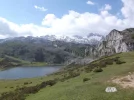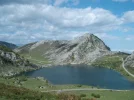- Time of past OR future Camino
- First: Camino Francés 2002; most recent: Norte/Primitivo 2019
One of the side-trips that I've long wanted to make from the Norte is the connecting pilgrimage to Covadonga. It could be said that Covadonga is where the reconquista began, as a group of Iberian Christians, led by Pelayo (not the hermit, the soldier!), won their first victory over the conquering Umayyad forces. From there, the kingdom of Asturias was formed and the resistance grew. Covadonga was a sight well chosen to make a defensive stand, situated in the foothills with many caves. A statue of the Virgin Mary, ultimately known as Our Lady of Covadonga (the patron of Asturias), was hidden in one of those caves and ultimately credited for the victory.
Given that, it's no surprise that Covadonga is the major Asturian pilgrimage site, alongside of Oviedo of course. A route to Oviedo is waymarked from Gijon and frequently overlaps with the Norte between Gijon and Amandi (near Villaviciosa), before splitting off on its own. I stayed in Amandi at the La Ferreria (which is great), and the location was ideal, as it's actually right on the route to Covadonga. I woke up the next morning and was off and running.
The best resource that I found for this walk online was the series of hand-drawn maps found on the Xurde Moran site (you've got to scroll down quite a ways to get to them). There are a couple of gps tracks online as well. By and large, though, I was just relying on the waymarks, which were quite dependable. In addition to the Covadonga symbol that appears quite often (see it here, pointing back from the Norte/Primitivo split), there are Camin a Cuadonga signs, and also blue and orange (or maybe pink?) arrows spray-painted on the road. From Amandi to Covadonga, I felt quite confident of the route throughout.
From Amandi to Covadonga, the walk spans 52km. It's around 70% on minor paved roads and 30% on trails/dirt roads. The first half of the walk is comparable to the Villaviciosa-Gijon walk (understandably enough), proceeding along minor hills on a valley's edge. As you get closer to Covadonga, the mountains grow around you, but there are rarely significant ascents/descents on this walk (the steps to Covadonga at the end might be the most strenuous climb). Most of the villages that you pass through are small. Facilities are sporadic and the bars early on don't open for breakfast, so you've got to plan accordingly. There are, however, some albergue turisticos along the way, including La Casona de la Figar in Miyares (20.5km from Amandi), Albergue El Puntual de Romillo (in Romillo/Rumillo, 33.5km from Amandi), and Albergue Cangas de Onis (aka Albergue La Riera), which is located not in Cangas but in La Riera, just 4km before Covadonga. There is also an albergue in Llames de Parres, La Pesa de Arriba, but it was reported to be closed this year.
Cangas de Onis is the lone town of any significant size along the way, some 40km from Amandi. It's a really nice spot, set right on the Rio Sella, with cafes set along the river and a few interesting sights. With regards to the route, a chunk of the walk lines up with what's known as the Camin de la Reina, which is said to be the route followed by Isabel II en route to Covadonga in the 19th century, and was originally a Roman road.
Covadonga is definitely accustomed to absorbing big crowds, but there is no special attention given to walking pilgrims. (Perhaps this is different in holy years.) When I arrived, despite it being an overcast and occasionally rainy day, there were lots of people visiting--both by car and tour bus. The two main components of the visit are: 1) the basilica, which is perched magnificently on a hill overlooking the valley below (despite the clouds, it was still stunning to see this appear far above me), and 2) the Holy Cave, where "Our Lady" is revered. Beyond that, there is a luxury hotel, a couple of cafes, and a souvenir shop. The small museum has a stamp available and I'm sure there's one in the basilica's sacristy as well--if you can get access.
Buses depart from Covadonga periodically for Cangas de Onis and there are some direct buses for Oviedo. To get back to Villaviciosa, to continue along the Norte, you'll want to bus to either Oviedo or Ribadesella, and then find a connection to Villaviciosa. There is a GR that connects Llanes/Poo and Covadonga (the GR-105.2--thanks to Valeria for this tip!), so one could theoretically through-hike from Llanes to Amandi via Covadonga, but I didn't have time to scout the Llanes-Covadonga option. I looked for any info in Llanes/Poo on this. The turismo in Llanes helpfully offers a few pages of info (a zoomed out map and some route descriptions), but there was nothing immediately evident in Poo where the route should have broken off from the Norte. Something for another time...
Anyway, I enjoyed the walk. While the weather wasn't totally accommodating, Covadonga is a striking spot and essential to the history of both Spain and the Camino. It's well worth a two-day detour.
Given that, it's no surprise that Covadonga is the major Asturian pilgrimage site, alongside of Oviedo of course. A route to Oviedo is waymarked from Gijon and frequently overlaps with the Norte between Gijon and Amandi (near Villaviciosa), before splitting off on its own. I stayed in Amandi at the La Ferreria (which is great), and the location was ideal, as it's actually right on the route to Covadonga. I woke up the next morning and was off and running.
The best resource that I found for this walk online was the series of hand-drawn maps found on the Xurde Moran site (you've got to scroll down quite a ways to get to them). There are a couple of gps tracks online as well. By and large, though, I was just relying on the waymarks, which were quite dependable. In addition to the Covadonga symbol that appears quite often (see it here, pointing back from the Norte/Primitivo split), there are Camin a Cuadonga signs, and also blue and orange (or maybe pink?) arrows spray-painted on the road. From Amandi to Covadonga, I felt quite confident of the route throughout.
From Amandi to Covadonga, the walk spans 52km. It's around 70% on minor paved roads and 30% on trails/dirt roads. The first half of the walk is comparable to the Villaviciosa-Gijon walk (understandably enough), proceeding along minor hills on a valley's edge. As you get closer to Covadonga, the mountains grow around you, but there are rarely significant ascents/descents on this walk (the steps to Covadonga at the end might be the most strenuous climb). Most of the villages that you pass through are small. Facilities are sporadic and the bars early on don't open for breakfast, so you've got to plan accordingly. There are, however, some albergue turisticos along the way, including La Casona de la Figar in Miyares (20.5km from Amandi), Albergue El Puntual de Romillo (in Romillo/Rumillo, 33.5km from Amandi), and Albergue Cangas de Onis (aka Albergue La Riera), which is located not in Cangas but in La Riera, just 4km before Covadonga. There is also an albergue in Llames de Parres, La Pesa de Arriba, but it was reported to be closed this year.
Cangas de Onis is the lone town of any significant size along the way, some 40km from Amandi. It's a really nice spot, set right on the Rio Sella, with cafes set along the river and a few interesting sights. With regards to the route, a chunk of the walk lines up with what's known as the Camin de la Reina, which is said to be the route followed by Isabel II en route to Covadonga in the 19th century, and was originally a Roman road.
Covadonga is definitely accustomed to absorbing big crowds, but there is no special attention given to walking pilgrims. (Perhaps this is different in holy years.) When I arrived, despite it being an overcast and occasionally rainy day, there were lots of people visiting--both by car and tour bus. The two main components of the visit are: 1) the basilica, which is perched magnificently on a hill overlooking the valley below (despite the clouds, it was still stunning to see this appear far above me), and 2) the Holy Cave, where "Our Lady" is revered. Beyond that, there is a luxury hotel, a couple of cafes, and a souvenir shop. The small museum has a stamp available and I'm sure there's one in the basilica's sacristy as well--if you can get access.
Buses depart from Covadonga periodically for Cangas de Onis and there are some direct buses for Oviedo. To get back to Villaviciosa, to continue along the Norte, you'll want to bus to either Oviedo or Ribadesella, and then find a connection to Villaviciosa. There is a GR that connects Llanes/Poo and Covadonga (the GR-105.2--thanks to Valeria for this tip!), so one could theoretically through-hike from Llanes to Amandi via Covadonga, but I didn't have time to scout the Llanes-Covadonga option. I looked for any info in Llanes/Poo on this. The turismo in Llanes helpfully offers a few pages of info (a zoomed out map and some route descriptions), but there was nothing immediately evident in Poo where the route should have broken off from the Norte. Something for another time...
Anyway, I enjoyed the walk. While the weather wasn't totally accommodating, Covadonga is a striking spot and essential to the history of both Spain and the Camino. It's well worth a two-day detour.

















